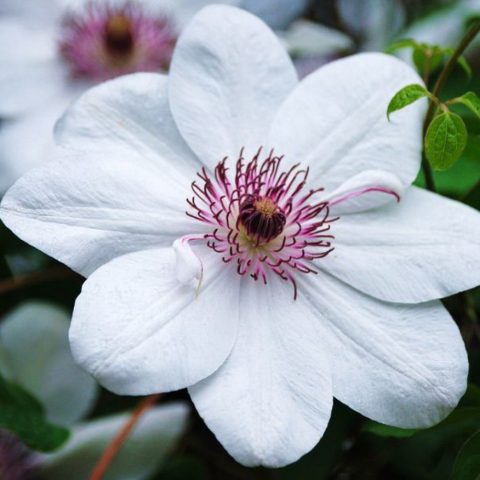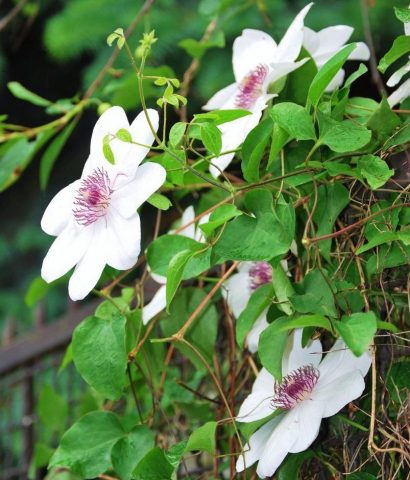Content
Of all the climbing plants, the clematis, used for vertical landscaping, are the most decorative. The culture is represented by different varieties with large and small flowers of all kinds of colors. Ornamental plants stand out for their original beauty. Description of Clematis Queen Jadwiga, photos and reviews will help you get a general idea of the bright representative of the species.
Description of Clematis Queen Jadwiga
Clematis Queen Jadwiga is the newest hybrid of Polish selection. The originator of the variety is Shchepan Marchinsky. This is a perennial herbaceous vine with ligneous stems and flexible thin shoots. It grows up to 2.5 m over the summer. The plant clings to the support with long leaf stalks.
Queen Jadwiga is a large-flowered variety with a long flowering period from late May until frost. Forms a large number of flowers, they cover the liana with a solid carpet. Flowers of the first spring wave are formed on overwintered shoots. Since August, there has been a profuse flowering of the second wave on the shoots of the current year.
The culture is frost-resistant, clematis is grown by Queen Yadviga in Siberia, the Far East, in the central part of Russia. The plant is light-loving, drought-resistant, does not lose its decorative effect with a lack of moisture, is widely used for design decoration of the territory in the South.
External description of Clematis Queen Jadwiga, shown in the photo:
- flowers are white with a velvet surface, bisexual, diameter - 17 cm;
- flowers consist of 7-8 sepals of an oblong oval shape, the edges are wavy, ribbed in the middle, with a lack of ultraviolet radiation, two longitudinal green lines are formed along the edges of the ribbing;
- stamens are formed in a semicircle of bright purple anthers located on long white bases;
- leaves are lanceolate, ternary, opposite, dark green, oval;
- the plant has a pivotal and fibrous root system, the root circle is about 50 cm;
- stems are round.
Clematis Queen Jadwiga is suitable for vertical gardening of arbors, planted between flowering bushes, near the walls of the building. It is widely used to form arches or walls that separate the zones of the garden.
Planting and caring for clematis
Clematis Queen Jadwiga requires moderately moist, neutral fertile soils for normal vegetation. Loamy or clayey with good drainage are suitable. Clematis gives abundant flowering only in bright light, so the plant is placed on the sunny side, protected from the north wind.
It is not recommended to allow rain streams from the roof to drain onto the liana, the flowers do not react well to the direct impact of water. In hot weather, the wall of knowledge heats up, which is also not desirable during clematis flowering. For a hybrid, it is necessary to install a support, it can be of all possible shapes. The photo shows an example of the placement of Clematis Queen Jadwiga on the site.
Planting a deciduous plant is carried out in early spring, you can transplant a bush in mid-summer or autumn. But they do it when absolutely necessary. After the formation of young shoots, clematis does not take root well.
Selection and preparation of the landing site
The place for planting clematis Queen Jadwiga is chosen taking into account the fact that the planting pits should be in the shade, and the shoots should be well lit by the sun. If the site is in a lowland, the Queen Yadviga variety is planted on a previously filled hill. The wells are prepared 1 week before planting clematis. The size of the landing recess is approximately 65 * 65, the depth is 70 cm.
- A drainage layer consisting of gravel is placed on the bottom.
- A mixture is prepared: 5 kg of compost, 50 g of superphosphate, 150 g of ash, 3 kg of sand, 200 g of nitrophosphate.
- The mixture is poured onto the drainage layer.
If the soil is acidic, neutralize it with any alkaline gardening agent.
Seedling preparation
If clematis has grown and needs to be divided, activities are carried out before the formation of young shoots (in early spring). Plants are separated only after a four-year growing season, taking into account that each bush has at least 4 healthy buds and a strong root system. These requirements are imposed when choosing planting material in a nursery. Before planting, for better rooting, the root system is immersed in the Heteroauxin solution for 5 hours.
Landing rules
If the clematis bushes Queen Jadwiga are transplanted to another site, they are buried 10 cm more than they grew in the old place. It is not recommended to plant too deeply, the plant slows down the growing season and may die. Young seedlings are placed so that there is a layer of soil no more than 8 cm above the root collar, for old clematis no less than 15 cm. After planting, the Queen Yadviga hybrid is watered with water with any drug dissolved in it that stimulates growth.
Watering and feeding
The root system of adult clematis penetrates into the ground up to 70 cm, this factor is taken into account when watering. A perennial plant is watered with a large volume of water (60 liters) under the root approximately 8 times during the growing season. They take into account weather conditions, are guided by the amount and frequency of precipitation. The root circle should be constantly wet, loosened, without weeds.
Young seedlings suffer greatly from drying out of the soil, they are watered with a small amount of water 2 times more often than an adult crop. When watering clematis, Queen Jadwiga take into account that the plant is large-flowered, the amount of water is increased during budding.
Clematis is fed 4 times per season:
- in May, after the appearance of young shoots, they give urea;
- before flowering, they are fed with Agricola-7;
- after flowering, organic matter is introduced;
- in the fall, fertilized with potassium sulfate and superphosphate.
Foliar dressing is given before the formation of buds, the variety of Queen Yadviga is treated with the "Bud" remedy.
Mulching and loosening
The soil around clematis is loosened by Queen Jadwiga at the first signs of drying out of the top layer of the earth. Mulching is necessary for young seedlings and old plants to prevent overheating of the root system and its waterlogging.
In the spring, it is recommended to spud the plant, after which the trunk circle is mulched with freshly cut grass, sawdust or a layer of humus. You can plant low-growing flowering crops around the bush. Symbiosis will provide clematis with protection of the root circle, and will provide flowers with periodic shading.
Pruning
In the fall, after the foliage has fallen, clematis is pruned. The plant is perennial, with intensive growth and shoots. Young stems are cut off completely, leaving only perennial vines. Weak branches are removed from them, the top is cut off at a height of 1.5 meters. In spring, perennial stems bloom and form young shoots, which will be covered with flowers in August.
Preparing for winter
In the South, clematis is cut in the fall, a layer of mulch is added and left for the winter, no additional measures are required. In temperate climates, a plant without shelter can freeze. Preparing for winter:
- Shoots are cut, removed from the support.
- Fold up in a ring and lay on spruce branches.
- Arcs are installed on top, covering material is pulled.
- The structure is closed with spruce branches.
In winter, they cover it with snow. If the aboveground part is frozen, it is cut off in the spring, clematis quickly recovers.
Reproduction
Clematis is propagated by Queen Jadwiga only in a vegetative way, the seeds after germination do not retain the characteristics of the mother plant. Reproduction by layering:
- they dig a shallow furrow to the length of a young shoot;
- place layering in the recess;
- places in the area of leaf internodes are covered with soil;
- leaves are left on the surface.
By the fall, clematis gives roots, in the spring, where the root system has formed, sprouts will appear. Layers are separated and planted for the next spring.
A fast way of propagation by cuttings from flowering shoots. The material is harvested in the spring before the buds are formed. Placed in the ground, constantly moisten. For the winter, the planting material is covered, in the spring they are planted.
Diseases and pests
Clematis is affected by a soil fungus, which causes vegetative wilting of the stems. Most of the infection affects plants up to 2 years of growth. Waterlogging of the soil and lack of sunlight provokes the growth of the pathogen. For prophylaxis, in the spring, the bush is treated with vitriol. Powdery mildew is more common. Eliminate colloidal sulfur disease with Topaz or Skor. Pests dangerous for the culture are slugs, they are disposed of with the help of metaldehyde.
Conclusion
The new Polish variety has not yet found widespread use among gardeners, the description of Clematis Queen Jadwiga, photos and reviews of flower growers will help make a choice in favor of a hybrid. The tall plant is completely covered with large white flowers. It will become a decoration of the landscape, the plant is used as a vertical gardening of an arch, gazebo or wall.











